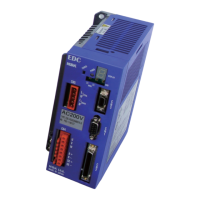— 6-14 —
6.3.2.2. Program Positioning Operation via RS-232C Communication
The command SP (Program start) starts a program operation.
Start the program in Figure 6-7 below as an example.
Fig 6-7: Program example
:
CH0
0?
MV0.500
1?
MA0.5
2?
ID9000
3?
:_
Rotational speed: 0.5 s-1
Rotational acceleration: 0.5 s
-
Move incrementally 90° in plus direction.
Program body
* Program processing pauses at this line for completion of positioning
Executes a
program from
the top line
The System secures settings of parameter until
completion of the program.(*1)
*1: It is possible to secure the parameter settings in the program after the
operation. Refer to “8.7.1. Change of Parameter via Program
Operation” for more details.
◊ The channel number 0 is used for the program. Input the command SP0.
:
P0
:>_
0
?
P S
ENT
The Motor moves 90° in the plus direction. The prompt is changed to “:>” from the
colon.
◊ The prompt “:>” indicates that the local parameter is applicable. This means that
parameters MV and MA specified in this channel are temporarily effective.
◊ When the program of channel 0 completes after the Motor moved for 90°, the global
parameter becomes effective again for the channel program.
Confirm completion of the positioning, then input the ENT
key to show the prompt
colon again.
:
P0
:>
:_
ENT
The prompt is changed to a colon.
The purpose of the prompt is to show which parameter, the global parameter or the local
parameter, should be read out on the screen.
◊ If the use of prompts to indicate effectiveness of the global parameter and the local
parameter interferes communication control, set the parameter PP (Parameter prompt)
to PP0, which cancels the function of the parameter prompt. The prompt is always the
colon in this state.
(The parameter PP requires the password.)
When RS-232C is used to set a parameter, you may set either parameter, the global parameter or
the local parameter, even when the prompt is “:>”.

